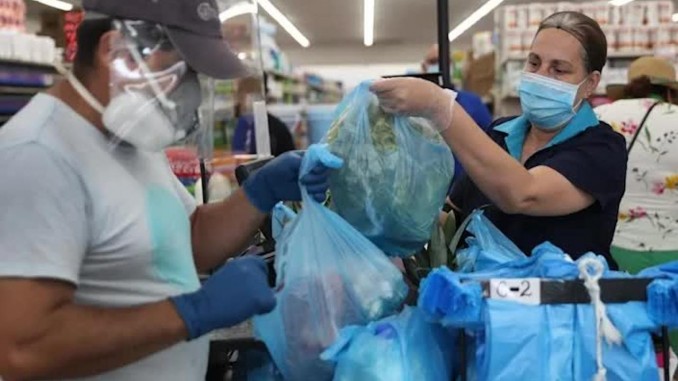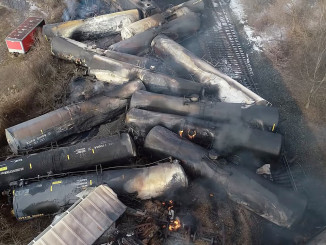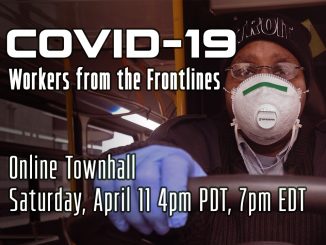
Background
At the time of writing this article, the COVID-19 pandemic has killed more than 550,000 people in the United States. The pandemic has exposed this society’s flawed and under-resourced public health system. It has also demonstrated the complete inability of world leaders to mount a response to the virus in a collective and organized way that is trusted by the population.
One of the consistent drivers of the pandemic has been transmission of the virus in workplaces. Despite governments implementing lockdowns on certain parts of the economy deemed “non-essential,” large numbers of workers in “essential” industries like transit, healthcare, and food production have allowed our society to keep functioning by working in unsafe conditions. This has allowed workplaces to become hotbeds of transmission as they are places where people are forced to interact, potentially becoming infected with the virus at work or spreading it to others.
While it is easy to blame a lot of this on the disastrous response by the Trump administration during the beginning period of the pandemic, these issues cannot and will not be solved under the Biden administration. We must recognize that there is a broader issue underlying this crisis– the capitalist system that governs how our society’s resources are produced and used.
Developing and enforcing safety protocols costs money and can result in decreased production due to the need for policies like physical distancing. This can result in decreased productivity and less profits. Workplace safety efforts during the pandemic have not been a priority because this system prioritizes profit for the bosses above all else. What are some ways in which this has happened?
Workplace Safety Agencies: Under-resourced and Toothless
The priorities are clear when we look at the role of governmental workplace safety agencies like the Occupational Safety and Health Administration (OSHA), which exist supposedly to regulate employers to defend the health and safety of workers.
The system is rigged against workers from the beginning. Compared to the number of workers and workplaces in the United States, these agencies are deeply under-resourced and understaffed. To help illustrate this, the head of OSHA under the Obama administration told reporters in 2013 that it would take OSHA 100 years to inspect every workplace in the United States once. This lack of enforcement presence has been even more criminal during the COVID pandemic. Recent investigative reporting by the Wall Street Journal showed that OSHA received 57,000 complaints related to COVID-19 between February 2020 and January 2021, and only sent inspectors to investigate 6% of them.
Besides understaffing issues, which prevents regulatory agencies from inspecting workplaces and enforcing regulations, capitalists and corporations are constantly fighting to weaken occupational health regulations. For example, in November 2020, Cal/OSHA (the OSHA of California’s state government) became one of the first state agencies in the United States with an “emergency COVID standard” which created new workplace safety laws and mandatory requirements for employee testing after workplace outbreaks. Immediately after it passed, employer groups such as the Western Growers Association, which represents corporate agriculture interests, sued Cal/OSHA arguing that the new law offering enhanced workplace protections was illegal. This is despite the fact that studies from UC Berkeley indicated that farm workers have tested positive for COVID at a rate at least 5 times greater than the general population of California!
In the rare instance when OSHA does inspect a worksite and cites an employer for violating a workplace safety law, large employers are able to use their immense legal resources to appeal the citation in court, which allows them to stall the process without implementing corrective action to address the safety concern.
If they are eventually fined, it is peanuts compared to how much money they make. For example, Cal/OSHA recently handed out the largest fine to a meatpacking company in the U.S. since the pandemic started. The $100,000 fine was against Smithfield Foods in Los Angeles County which has had several hundred workers in their facility test positive for COVID. In 2018 the Chinese parent company WH Group that owns Smithfield Foods made $1.05 billion in profits!
COVID-19 Science: Our Understanding Has Evolved, But Workplace Standards Have Not
Another way that workplace safety protocols have failed during the pandemic is that they have not evolved based on new research about how the virus spreads. This has been a failing of most global public health authorities and governments.
During the beginning of the pandemic, it was hard for scientists to provide definitive information about what to do because they did not completely understand how the virus spread. This was exacerbated by the political response of many governments during the initial phase of the pandemic. Instead of mobilizing resources to immediately stop the spread of the virus and study its characteristics, most governments downplayed the virus because they were resistant to shutting down parts of the economy and forcing capitalists to miss out on profits. This led to a situation in which the virus spread rapidly across the globe while scientists and public health officials played “catch-up.”
To understand how our knowledge of COVID has evolved, it is important to know a bit about how the body works. Human beings are constantly releasing respiratory fluids and particles when we do things like talk or cough. These particles can vary greatly in size, and their size influences how they behave physically once they leave the body.
Scientists generally refer to larger fluids that are released when we cough or sneeze as “droplets,” while referring to tinier particles that we release when we talk or sing as “aerosols.” “Droplets” are big enough that when they are released, they will fall to the ground a few feet from your body. “Aerosols” on the other hand are so light that they can remain suspended in air for a longer amount of time.
Initially, most scientists assumed that the virus was spread by direct exposure to “droplets” (getting coughed or sneezed on at close range), or by exposure to “droplets” on surfaces (touching a surface where someone has coughed or sneezed and then touching your face).
But as our understanding of the virus evolved, scientists now believe that most transmission of the virus is actually happening by people inhaling virus-containing “aerosols” exhaled by infected individuals, in addition to the virus spreading by droplets in the air or surfaces.
Scientists have a good analogy to think about how aerosols behave and that is to think of how smoke behaves. If one imagines a group of people cramped in a small indoor space and smoking cigarettes, very soon the room would be filled with smoke! When we talk or exhale, the aerosols we release behave in the same way but are not visible to the naked eye.
If someone is infected and exhaling virus-containing aerosols, they can “build up” in the air particularly in cramped indoor environments just like cigarette smoke would. As the particles remain suspended in air, they can be inhaled and infect others—even if they are wearing a cloth or surgical mask. The aerosol particles are small enough that they can travel around small gaps between someone’s mask and their face when they inhale, especially if the mask is not fitting snugly.
Because of this, in addition to social distancing and sanitizing surfaces, scientists have been trying to sound the alarm on the importance of producing more N95 masks for workers and the public, which are specially designed masks that fit tightly to people’s faces and filter out aerosols. These masks protect wearers from contracting COVID through the air. Scientists are also emphasizing the importance of having well-ventilated workplaces as good ventilation can both filter and dilute the build-up of virus in the air, which makes it less likely to infect others.
To this day, the scientists’ pleas have fallen on deaf ears as no federal workplace standard mandating things like improved ventilation or making N95 masks available for all workers has been passed. Both Trump and Biden have tried to invoke emergency production of more N95 masks but these efforts have been insufficient so far.
Why Have There Been Inconsistent and Even Wrong Workplace Safety Guidelines? Public Health Operating Under Capitalist Pressures
Why have the Centers for Disease Control and Prevention (CDC), OSHA, and other parts of the U.S. government dragged their feet on explaining the importance of aerosol transmission in workplaces? There are many reasons for this, and several of them are connected to the question of resources rather than good science.
One reason there has been a reluctance to describe the coronavirus as “airborne” is because the word has a specific meaning in hospitals. If a disease is labeled “airborne,” then the hospital must use negative-pressure isolation rooms to treat patients and use more protective masks such as N95, which is more complicated, expensive, and resource-intensive to do.
Additionally, during this pandemic, worker safety policies on masks inside hospitals have been heavily influenced by supply shortages of N95 masks. This is similar to the first months of the pandemic, when the CDC advised against the use of masks, arguing that limited supply needed to be saved for healthcare workers. They did this not because they thought masks were ineffective, but because they were worried that since mask supplies were so low in the country, it would cause shortages in hospitals if big portions of the public tried to buy masks all at once.
Although there is no clear proof, the same rationale has likely influenced the CDC’s reluctance to acknowledge aerosol transmission. Lobbying groups representing hospitals are known to try to influence CDC policies. It would also be in the interest of hospital administrators to resist the notion that the virus is airborne because they have often not had enough N95s and isolation rooms to treat COVID patients and are under pressure to reduce costs.
Similar factors apply to the question of ventilation. Even if improved ventilation regulations were passed, capitalist society is not equipped to implement these changes in a quick way without bosses being forced to spend large amounts of money. Many workplaces in the U.S. feature old, poorly maintained buildings with dilapidated ventilation systems that would require major renewal.
Acknowledging and doing something about aerosol transmission would mean retrofitting the ventilation systems of most buildings and schools in the United States. This also poses questions about the safety of labor-intensive, and densely occupied industrial workplaces as in the meatpacking industry. It is not in the profiteering interest of companies to address the problems, so part of what companies have done is pay lawyers to testify before Congress, downplaying the need for emergency COVID safety regulations at the federal level, which influences the CDC’s and OSHA’s positions.
Finally, another key reason for this is the CDC and U.S. government generally are under pressure to fully reopen the economy and schools. Now that vaccines are available, vaccines are the preferred solution by the capitalist class to deal with the pandemic as opposed to spending money on workplace safety measures. Vaccines are not a substitute for robust workplace safety protocols, however, as we do not fully understand the effectiveness of vaccines against different variants of the virus, and we also know that not all individuals will take the vaccine. Reopening schools with vaccinated teachers also overlooks the role the students can play in spreading the virus even if they may not get sick or develop symptoms.
Conclusion
Any strategy to operate a workplace safely requires resources and a plan. Among many things in this pandemic, it requires well-trained experts to study how the virus spreads and develop safety protocols to prevent workers from being infected. It requires clear communication to workers about the steps we need to take both individually and collectively to fight the spread of the virus at work. Most importantly, it requires putting safety first. This is in contradiction to the fundamental basis of capitalist production—the generation of profit for the owning class. It would mean that workers would have to have control over the organization of work so it can be reorganized in a safe manner.
Although the government has competent and well-intentioned scientists who generate useful information, its guidelines must be seen through the lens of the capitalist-controlled society we live in. It will not contradict the interests of the system it serves. A truly trustworthy pandemic response cannot come from a capitalist government and its agencies. What we need is information, resources, and control over these resources not limited by the priorities of an unjust system. That will only come from a government created by and for working people and the poor, where working people are in charge of organizing work to meet society’s needs in a safe manner.




